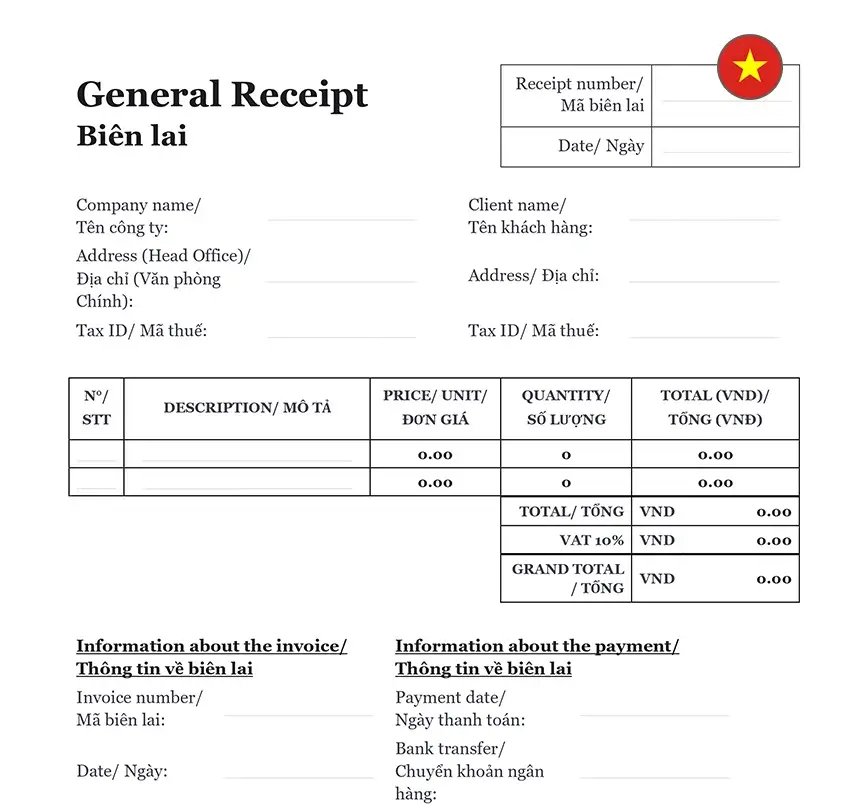This type of receipt is often used in scenarios where formal invoicing is not required, such as small retail transactions or minor service payments. For more detailed guidance on the format and content necessary for general receipts, refer to the General Department of Taxation’s website.
Issuing payment receipts in Vietnam must comply with the following legal requirements:
1. Mandate for Issuance: All businesses and individuals are required to issue payment receipts for transactions that exceed a specified monetary threshold. This requirement ensures that significant transactions are documented and verified.
2. Regulatory Guidelines: The issuance of payment receipts must adhere to the Law on Tax Administration and regulations established by the Ministry of Finance. These guidelines detail the necessary components and format for valid receipts.
3. Accuracy and Completeness: Payment receipts must include accurate and complete details about the transaction. This includes essential information such as the amount paid, date of payment, payer and payee details, and the purpose of the payment.
4. Transparency and Accountability: The legal framework aims to enhance transparency and accountability in financial transactions. Proper documentation helps prevent tax evasion and ensures that all financial activities are recorded accurately.
5. Compliance Importance: Adhering to these regulations is crucial for avoiding legal issues and ensuring smooth business operations. Compliance with the legal requirements helps businesses maintain proper financial records and avoid potential disputes.
When issuing payment receipts, ensure that the following components are included to guarantee completeness and legal compliance:
Receipt Number: A unique identifier for each transaction, ensuring that each receipt can be distinctly tracked.
Date of Payment: The exact date when the payment was made, providing a clear record of the transaction timing.
Payer’s Details: The name and contact information of the payer, confirming who made the payment.
Payee’s Details: The name and contact information of the payee, identifying who received the payment.
Amount Paid: The total amount of money received, stated in both numerical and written formats to prevent discrepancies.
Payment Method: The method used for the payment, such as cash, bank transfer, or other methods, detailing how the transaction was completed.
Purpose of Payment: A brief description of what the payment was for, offering clarity on the transaction’s purpose.
Including these components ensures that the payment receipt is thorough, accurate, and serves as valid proof of the transaction.
With the advancement of technology, electronic payment receipts have become increasingly prevalent in Vietnam. These digital receipts offer a convenient alternative to traditional paper receipts, streamlining the process and reducing the need for physical documentation. Electronic receipts must adhere to the same legal requirements as their paper counterparts, including the need for accurate details and proper documentation. They should be accompanied by digital signatures to authenticate the receipt and ensure its validity. For more information on the regulations governing electronic payment receipts, including their legal acceptance and technical requirements, consult the Vietnamese Ministry of Finance’s regulations. This resource provides guidance on how to issue and manage electronic receipts in compliance with Vietnamese law.
Learn more about Protecting Your Brand Name in Vietnam to ensure your business practices are fully compliant and secure.
For businesses operating in Vietnam, issuing payment receipts is crucial for both legal compliance and financial management. Key aspects include:
Maintaining accurate records of payment receipts is vital for ensuring compliance with Vietnamese tax laws. Businesses and individuals are required to keep copies of all issued and received receipts for a specified period, as stipulated by law. This record-keeping practice is essential for proving compliance during tax audits and financial reviews. Proper documentation helps in tracking financial activities, managing cash flow, and resolving any disputes that may arise. Ensuring that receipts are accurately recorded and stored in an organized manner helps in meeting legal requirements and facilitates smooth financial management.
When issuing payment receipts, it’s essential to avoid common mistakes to ensure accuracy and legal validity. Here are some frequent errors to watch out for:











